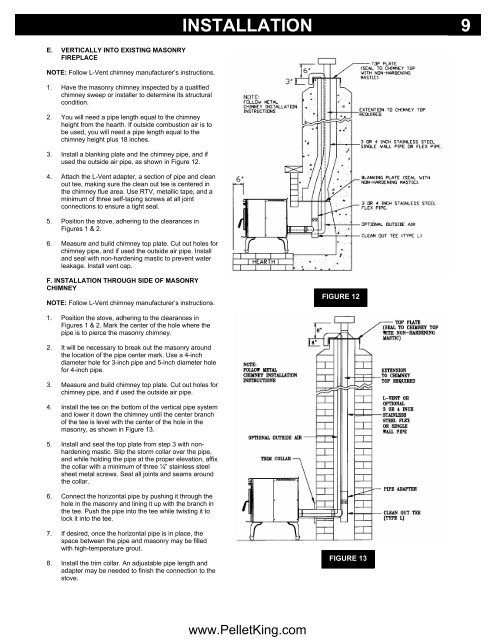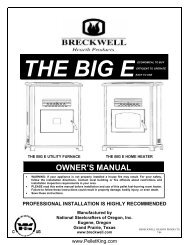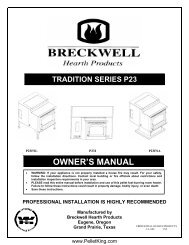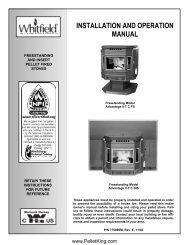P22 2004 Manual - Wood Pellet Stoves
P22 2004 Manual - Wood Pellet Stoves
P22 2004 Manual - Wood Pellet Stoves
Create successful ePaper yourself
Turn your PDF publications into a flip-book with our unique Google optimized e-Paper software.
E. VERTICALLY INTO EXISTING MASONRY<br />
FIREPLACE<br />
NOTE: Follow L-Vent chimney manufacturer’s instructions.<br />
1. Have the masonry chimney inspected by a qualified<br />
chimney sweep or installer to determine its structural<br />
condition.<br />
2. You will need a pipe length equal to the chimney<br />
height from the hearth. If outside combustion air is to<br />
be used, you will need a pipe length equal to the<br />
chimney height plus 18 inches.<br />
3. Install a blanking plate and the chimney pipe, and if<br />
used the outside air pipe, as shown in Figure 12.<br />
4. Attach the L-Vent adapter, a section of pipe and clean<br />
out tee, making sure the clean out tee is centered in<br />
the chimney flue area. Use RTV, metallic tape, and a<br />
minimum of three self-taping screws at all joint<br />
connections to ensure a tight seal.<br />
5. Position the stove, adhering to the clearances in<br />
Figures 1 & 2.<br />
6. Measure and build chimney top plate. Cut out holes for<br />
chimney pipe, and if used the outside air pipe. Install<br />
and seal with non-hardening mastic to prevent water<br />
leakage. Install vent cap.<br />
INSTALLATION 9<br />
F. INSTALLATION THROUGH SIDE OF MASONRY<br />
CHIMNEY<br />
NOTE: Follow L-Vent chimney manufacturer’s instructions.<br />
FIGURE 12<br />
1. Position the stove, adhering to the clearances in<br />
Figures 1 & 2. Mark the center of the hole where the<br />
pipe is to pierce the masonry chimney.<br />
2. It will be necessary to break out the masonry around<br />
the location of the pipe center mark. Use a 4-inch<br />
diameter hole for 3-inch pipe and 5-inch diameter hole<br />
for 4-inch pipe.<br />
3. Measure and build chimney top plate. Cut out holes for<br />
chimney pipe, and if used the outside air pipe.<br />
4. Install the tee on the bottom of the vertical pipe system<br />
and lower it down the chimney until the center branch<br />
of the tee is level with the center of the hole in the<br />
masonry, as shown in Figure 13.<br />
5. Install and seal the top plate from step 3 with nonhardening<br />
mastic. Slip the storm collar over the pipe,<br />
and while holding the pipe at the proper elevation, affix<br />
the collar with a minimum of three ¼” stainless steel<br />
sheet metal screws. Seal all joints and seams around<br />
the collar.<br />
6. Connect the horizontal pipe by pushing it through the<br />
hole in the masonry and lining it up with the branch in<br />
the tee. Push the pipe into the tee while twisting it to<br />
lock it into the tee.<br />
7. If desired, once the horizontal pipe is in place, the<br />
space between the pipe and masonry may be filled<br />
with high-temperature grout.<br />
8. Install the trim collar. An adjustable pipe length and<br />
adapter may be needed to finish the connection to the<br />
stove.<br />
FIGURE 13<br />
www.<strong>Pellet</strong>King.com






